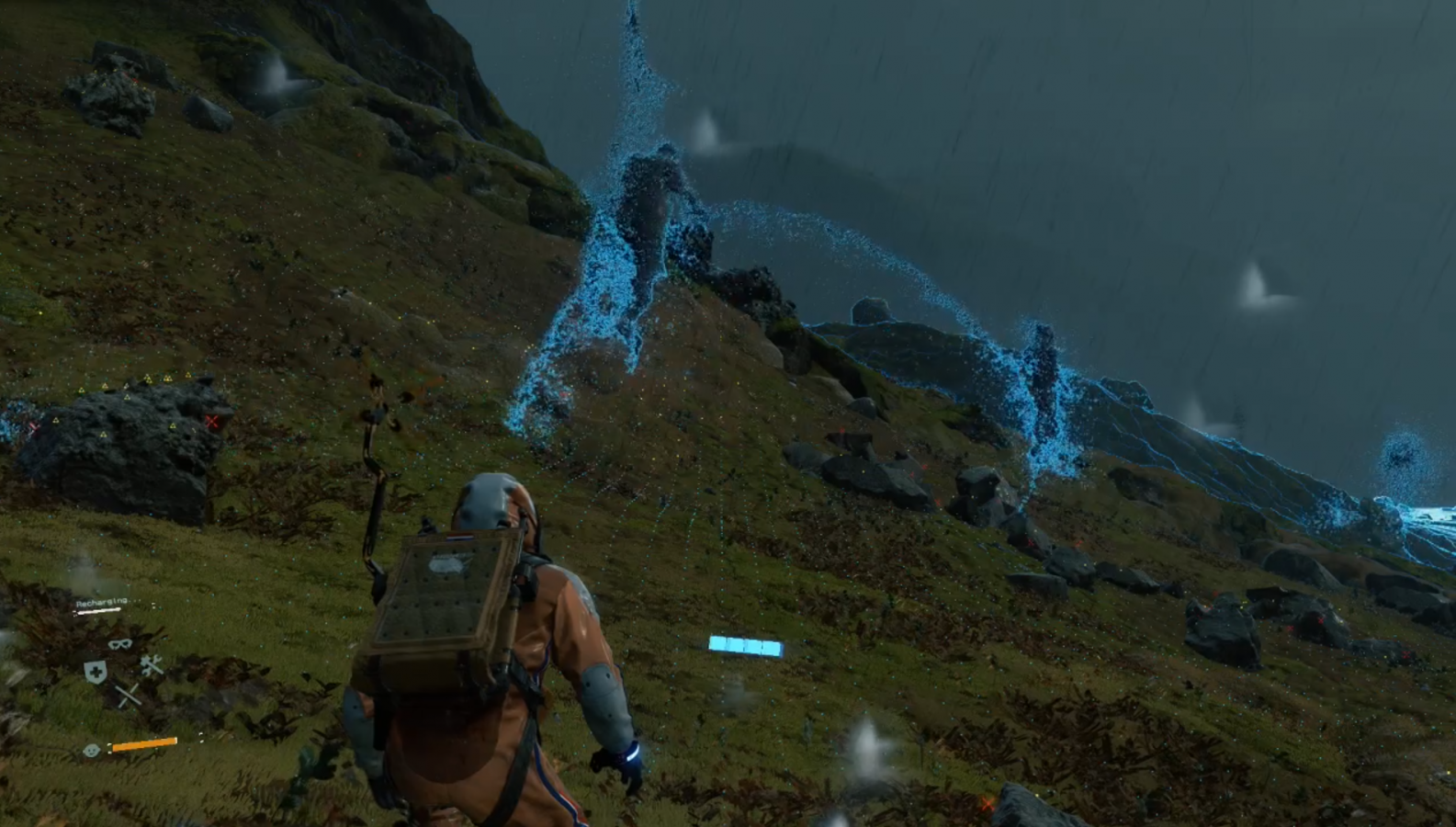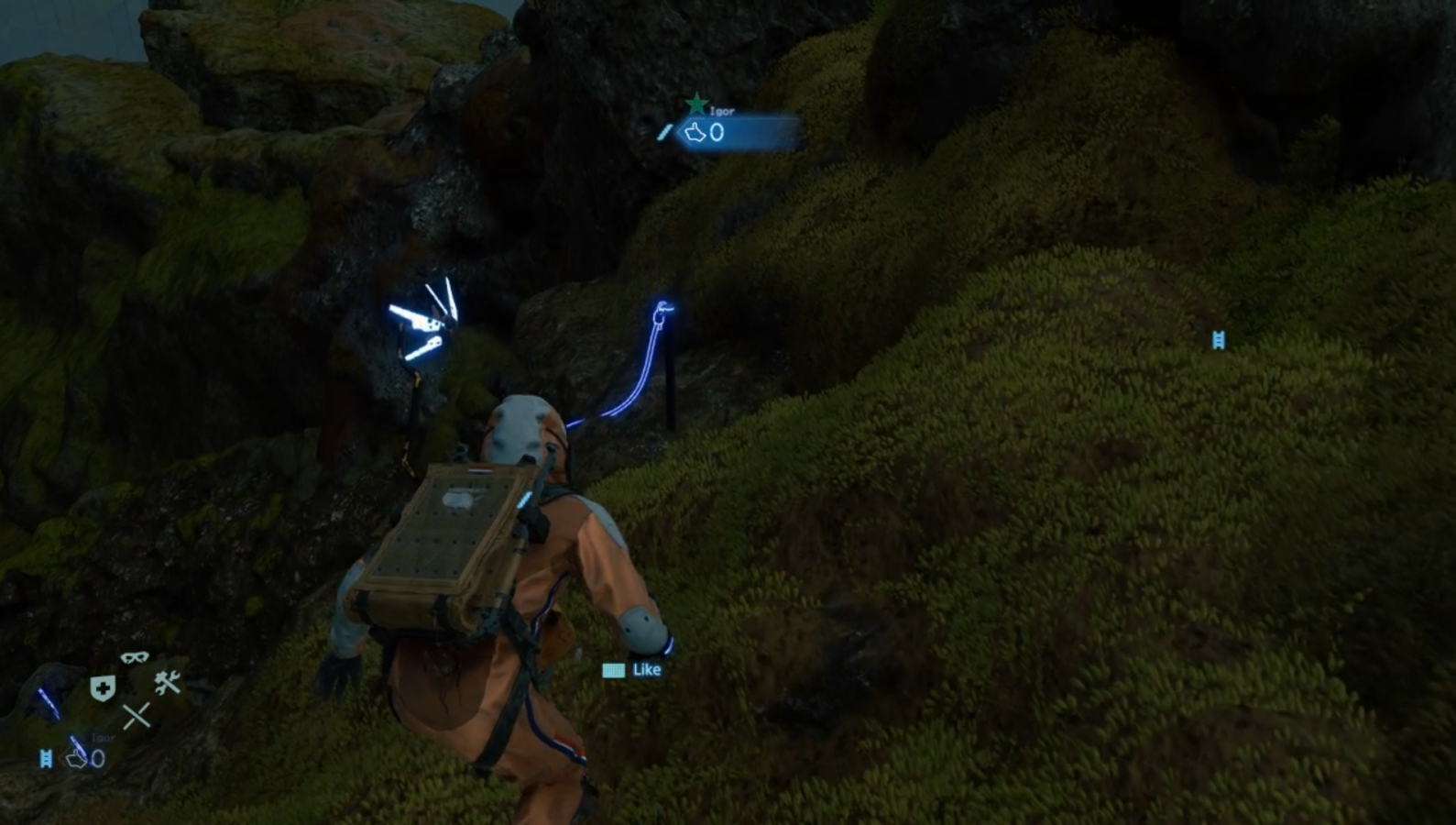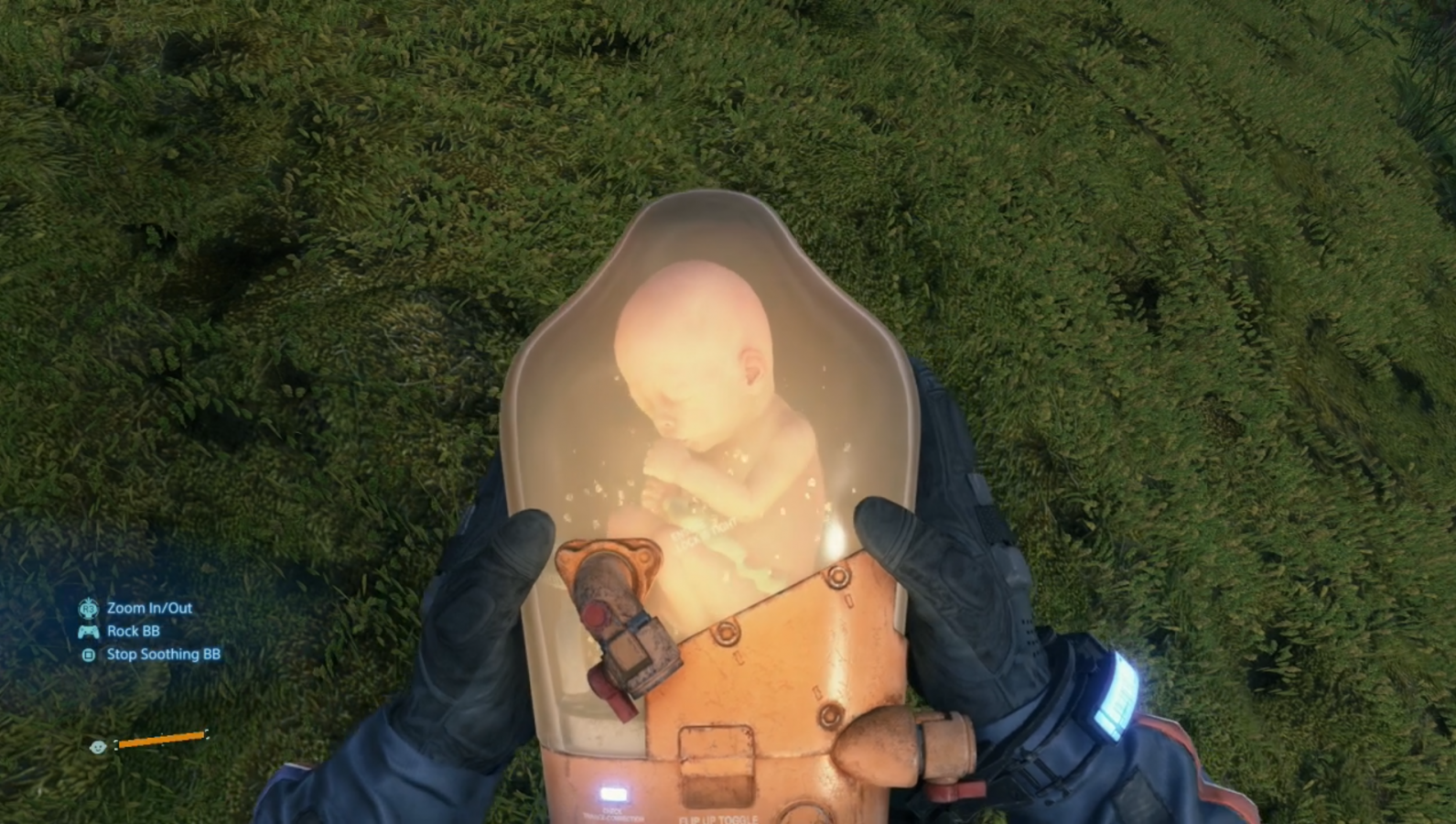As time has passed, the world has become more and more connected. We went from being spread out with no way to communicate except in person to being able to communicate on the plethora of social media we have now. The point is that we have the power to communicate globally in an instant and that has made us stronger and more unified. Now, what if that idea of unification and connection was the main aspect behind a game’s premise? Look no further; take the theme of connection and mix it with some action-adventure gameplay, a fantastic cast, and a whole heap of Hideo Kojima’s trademark crazy style. That, my friends, is how we’ve discovered the Death Stranding.
I’d like to say that Death Stranding is an interesting game, but I believe that’s drastically underselling it. The plot, although seemingly basic at first, gets stretched out and expanded upon as you embark on your journey. You play as Sam Porter Bridges, one of America’s brave porters (short for transporters) who makes his living off of delivering things for anyone in need. His knack for speedy deliveries and products in pristine condition has earned him a reputation as one of the best. Why is he so brave you may ask? That’s because a catastrophic event known as the Death Stranding has occurred, resulting in a massive casualty count, a deadly tar that absorbs most things that enter it, deadly creatures known as BTs manifesting, and America being torn apart (both literally and metaphorically).

The company that Sam works for, Bridges, is attempting to reconnect America and form the United Cities of America in order to restore the country to what it once was. To do so, they sent out expedition teams to make contact with other communities and individuals in the hopes of connecting them to the system they call the Chiral Network. Think of it as a highly advanced version of the Internet. Sam has no interest in the future of the country, but it turns out that his dear friend Amelie got captured and held hostage on the West coast while she was with one of the expedition teams. Now, hands essentially tied, Sam reluctantly goes along with Bridges’ plan and heads West to finalize the connections to the Chiral Network, and get closer to saving Amelie.
The game is open-world, so you’re able to travel pretty much wherever you want from the get-go. I say pretty much because there are some areas that you don’t get access to until later on when the story needs you to go there. That being said, wow is this world vast. From the flowing rivers to the steep mountains to the snowy hills to the wasteland-like fields, everything looks gorgeous, albeit it in a post-apocalyptic kind of way. There’s way more of a focus on nature in Death Stranding’s environment, with civilization sprinkled here and there. Those vast expanses added to the sense of disconnectedness and emptiness that America had been facing as a result of the Death Stranding. Be forewarned, you will be traveling a lot. For people who like the journey more than the destination, you’ll feel right at home, especially if you feel that pride of successfully making your way down an arduous path. Don’t worry though, after some time you’ll get access to some vehicles that help you get from place to place much quicker. That being said, you’ll still be walking and running quite a bit.

Besides walking and running to complete deliveries, the gameplay does offer stealth sections, combat, and inventory management. The stealth sections are incredibly well done. As mentioned earlier, creatures called BTs have manifested. These are shadowy humanoid beings with long cords attached to them. One of your tools, the Odradek, will warn you when you’ve entered an area swarming with BTs. The Odradek looks like an extended version of a claw-machine claw combined with the front panel of a Ghost from Destiny. The Odradek will turn to face the closest BT and change colors, picking up speed as you get closer to them. When a good distance away, it stays blue and slightly moves, but when you get really close, it turns yellowish orange and starts opening and closing rapidly. In these situations you’ll want to crouch walk and hold your breath if the game prompts you to. The Odradek movement and noise doesn’t affect the BTs, so don’t worry about it getting you killed. If you make too much noise, they’ll discover that you’re there and attack. If you get caught, you’ll take damage and get dragged around in some tar by humanoid creatures. You can’t outrun the BTs, so don’t even try. The louder you get, the faster they’ll hone in on you, and believe me when I say that they are much faster than you.

Early in the game, combat is going to be practically non-existent other than throwing some punches. As you progress, you’ll get access to an arsenal of weapons such as various types of grenades, assault rifles, handguns, shotguns, and more. That being said, this is not a guns-blazing type of game. There aren’t a lot of gunfights or battles, but the weapons are there to help you when you need them. They are most often used for defending yourself, but there are a few cases where you must go on the offensive. It’s better to discover the specifics during your playthrough, but I’ll vaguely mention that regular bullets aren’t the only ammunition you’ll get access to. The special ammunition was actually pretty neat to me when it came up during my playthrough.
Now, as a porter, you’ll be tasked with carrying supplies to various destinations. You’ll also be able to carry your own assortment of weapons, along with tools such as ladders and climbing anchors, blood bags for healing, and much more. This isn’t your typical “cram an unrealistic amount of stuff into your inventory” type of game. Everything you carry has a weight to it, and that weight takes a toll on poor Sam. Sam can handle a hefty amount of weight, but he still has his limits. As you progress, he’ll be able to handle more weight and get better at doing so. Besides being slowed down as a result of the weight, Sam can also lose his balance. Quick movements can cause your cargo to sway, forcing Sam to balance himself out in order to avoid falling over. The more cargo you have on you, the harder it will be to stay balanced. This adds a whole new level of inventory management; now your inventory space actually impacts your gameplay. You also have to be careful with balance on slopes and hills, but thankfully you can hold down L2 and R2 in order to grip your backpack straps to steady yourself easier. Oh, and if you fall, not only will you take damage, but your cargo will as well. All objects have a durability that you’ve got to carefully maintain during deliveries, so keep that in mind.

While out in the world, you’ll be able to find lost cargo and extra materials that you can take back to shelters. You can recycle the materials in order to stock up and use them to fabricate tools later on such as ladders, climbing anchors, PCC (a tool that you sacrifice in order to build something like a bridge or a generator), boots, vehicles, and much more. Quick note, I mention boots because your boots have a durability meter that drains as you walk on them. Once they get low and almost ruined, you’ll need to fabricate a new pair. The material cost is extremely low and you can always carry more than one extra pair, so it should never be an issue. Turning in lost cargo nets you extra experience to increase your level and also rewards you with likes. You earn experience from completing deliveries, and leveling up improves your ability to keep your balance, carry more cargo, earn more likes, and more.
I’m sure you’re wondering what I mean by likes. It caught me off guard at first too, but turns out it’s a neat little concept. Likes help improve your connection level with NPCs in certain locations, which in turn increases the amount of materials you can store in a given location. This is helpful because every location has its own private storage locker and its own material storage. This limitation is more realistic and prompts you to do more for the people in that area if possible. Basically, since people appreciate your efforts, they’re more willing to help you out with more things. You can earn likes from NPCs by completing tasks and likes from other players by helping them out in their games. Oh…did I forget to mention that even in a single-player game, you can have an impact on someone else’s experience?
The quasi-multiplayer aspect of Death Stranding was one of the most unexpected yet amazing things that they decided to try out. When you place a tool such as a ladder or climbing anchor or build a structure such as a bridge or generator in the world, it isn’t limited only to you. At any given time, even though you may not be able to see them, you may be playing alongside somebody else. You have no way to directly impact each other, but if you press the “call out” button, you’ll yell, and if you’re lucky, another nearby player may do the same and yell back to you. It’s fascinating knowing that in an odd way that you’re connected to other gamers even though you aren’t directly playing together. Seeing that somebody left behind a ladder to get up onto a ledge makes your life easier, so why not reward that ladder with a like? You may be fearful that the world of Death Stranding will become littered with tools once it fully releases, but fear not, the developers thought of that. It isn’t just one massive server, but a collection of them which helps alleviate any chance of overcrowding from tools and structures. There are also shared lockers at the shelters where you can deposit items for other players to find and use at their leisure. Again, that sense of community and unification rears its head, which I appreciated whole-heartedly.

Related to the overcrowding concern, the game has a major feature to grapple with that concern: Timefall. At first, Timefall looks just like normal rain, and you may be tempted to want to play in it, but it isn’t and you shouldn’t. Timefall is another drastic effect of the Death Stranding. Whatever the raindrops touch gets fast-forwarded and more fragile as a result. That ladder you placed starts to get rusty faster, while the cargo containers you’re carrying start to decay and fall apart. Your skin, however, gets old and wrinkly in just a few seconds. Thankfully Sam always immediately wears his protective hood whenever it rains, so you don’t have to worry about protecting Sam in that regard. As I said, everything fast-forwards, but in terms of gameplay, the rate of accelerating decay is fairly lenient. You should still attempt to get out of the Timefall as quickly as possible in order to protect your gear and cargo, but you don’t have to worry about everything crumbling in your arms within a short time.
I mentioned a fantastic cast earlier, and I need to reiterate how perfect everyone was for their roles. Norman Reedus as the tough adventurer with a hidden heart of gold, Guillermo del Toro as the researcher with an unnaturally joyful interest in the dead, and Troy Baker as a cocky antagonist, just to name a few. You can feel the emotion from their voices, whether they’re sad, angry, confused, and so on. The fact that everyone’s characters are modeled after their real life counterparts enables them to bring their characters to life to a much greater extent. Seeing Norman Reedus and hearing his voice is such a treat for fans of his. The same goes for the entirety of the main cast.

Now, as a whole, it’s hard to narrow down my favorite thing about the game. That’s not to say it’s bad; in fact, it’s quite the opposite. I have so much to say about Death Stranding that I could talk for hours about it if prompted to. It made me laugh, cry, gasp in surprise, tense up in excitement, frustratingly mutter to myself at times, and even peacefully relax during the long “road trips” so to speak. For a game that at a glance looks to be about a man transporting goods in a ruined America, it had much more going on than you’d think. This game wasn’t what I was expecting it to be, but at the same time I’m so glad it wasn’t. Hideo Kojima and Kojima Productions hooked me in right away with their storytelling, multitude of interesting mechanics, and of course Kojima’s trademark brand of off-the-wall insanity. More than that, the main takeaway from the game, the main message of it all is what really stuck with me: We are all connected. We should be unified as a people, as a society, and as a community. No matter what stands in our way, if we stay strong, help one another out, and strive towards greatness as a unified force, then there’s nothing that we can’t accomplish. In the end, Death Stranding isn’t an action-adventure game about a man crossing the country in order to save his friend, it’s a social-connection game about one man and his comrades working together in order to bring people together again.
Codi loves to play video games and watch movies. He will watch almost any kind of movie just to experience them. His ideas take inspiration from the shows and movies he watches, and games he plays. He also loves a good pun.

Death Stranding is a story of rebuilding America by connecting people far and wide. Stealth, exploration, combat, and inventory management are all necessary in order to succeed. With a fantastic cast, incredible set pieces, an engaging story, and Kojima's brand of incredibly enjoyable crazy, you won't want to put your controller down.
PROS
- Engaging story with twists and turns
- Stealth, exploration, combat, and inventory management mesh well
- Amazing cast and incredible open-world
- Kojima's trademark weirdness alongside a beautiful message about connections
 Buy Now
Buy Now
 Buy Now
Buy Now
 Buy Now
Buy Now
 Buy Now
Buy Now
 Buy Now
Buy Now
 Buy Now
Buy Now















